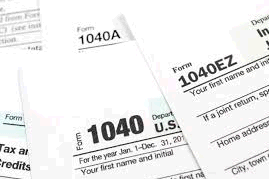What You Can Learn from Your Tax Return: Form 1040
Apr 11, 2018 • Written by Paul Staib | Certified Financial Planner (CFP®), MBA, RICP®
Blog Home » Asset Allocation » What You Can Learn from Your Tax Return: Form 1040

Between the Tax Cuts and Jobs Act of 2017 (TCJA), SECURE ACTs, and the changes to the 1040 tax form(s) itself, there have been significant changes to manage through over the past few years. That said, reviewing your tax documents can offer valuable intelligence about your investment and financial life. Rather than focusing just on the bottom line of your tax return – what you owe or what you’re getting back – it pays to take a closer look at what’s actually on those forms. Here are some of the key items to focus on.
1040, Line 1: Wages, Salaries, Tips, etc.
Compare this figure for to your prior year tax return. Is the trend a positive one? In a strong economy, it should be, barring mitigating factors such as a job change or loss. If your wages have barely budged or have gone down, consider whether a change is in order. Is it time to ask for a raise, change jobs, and/or improve your skills through an investment in additional education? Also consider the opposite scenario: If your wages are trending up but you’re in a job that’s making you miserable or leaving you no time for activities that enhance your quality of life, give some thought to enacting change.
Remember that phantom income has the potential to inflate the number you see here–if you’ve received restricted stock units from your employer that have vested, for example, the amount that vested in 2018 will show up in your wages, even if you haven’t sold the stock and pocketed the money.
Alternatively, you may notice that the amount on this line is lower than what you know to be your gross income. That’s because it shows your gross income less any of your pretax deductions, such as health insurance premiums, your contributions to a health savings account or flexible spending arrangement, or contributions to a traditional 401(k) or other defined-contribution plan.
1040, Line 2: Interest Income
You can see the raw dollar amounts of your interest income on this line: Tax-exempt interest, usually from municipal bonds, is in Box 2a and taxable interest is in Box 2b. If you have a high level of taxable interest income, make sure that you’re paying attention to asset location and have assessed whether taxable bonds and money markets, rather than municipals, are truly the better bet for your taxable savings, once the tax effects are factored in. Now that cash and bond yields are finally decent, the negative tax effects of improper asset location will be more meaningful.
In a related vein, pay attention to which of your financial institutions issued 1099s for the year. If you didn’t receive a 1099 from financial institutions where you know you hold cash, such as your bank, don’t be alarmed; it’s possible that your interest was less than $10, so the institution doesn’t need to send you a 1099. You’re technically still required to report that interest, however; you should be able to find the amount online.
1040, Line 3: Dividends
This line shows the dividends you received last year; those that count as qualified – meaning that they’re subject to the more-favorable qualified dividend tax treatment – are in Box 3a and ordinary dividends are in 3b. As with taxable interest above, take a hard look at any investments, such as REITs, that are paying nonqualified dividends that you’re being taxed on; those investments are better housed in a tax-sheltered account such as an IRA, if possible. In a similar vein, some of your dividend-focused mutual funds may hold investment types like convertibles and preferred stocks to boost their income; income from those securities doesn’t typically qualify for the favorable qualified-dividend treatment.
1040, Line 4: IRA Distributions
If you’re retired, line 4 (IRA), 5 (Pensions and Annuities), and 6 (Social Security benefits) are where most of your income action is apt to be. You’ll also have an entry on Line 4 if you converted traditional IRA assets to Roth. If you’re making backdoor Roth IRA contributions because you earn too much to make a direct Roth IRA contribution, make sure you’re documenting those nondeductible contributions via IRA Form 8606.
1040, Line 5: Pensions and Annuities
If you’re receiving pension and/or annuity income, Line 5a will contain the gross income and Line 5b will contain the taxable amount.
1040, Line 6: IRAs, Pensions and Annuities
If you’re receiving Social Security benefits Line 6a will contain the gross income and Line 6b will contain the taxable amount. Refer to Taxation of Social Security to understand how your Social Security benefits are taxed, and How to Minimize Taxes on Social Security.
1040, Line 7: Capital Gain (or Loss)
Many investors may have realized sizable capital gains in recent years – whether they sold appreciated winners from a taxable account or one or more of their mutual funds realized gains and made a distribution. If one of your fund holdings made a big capital gains distribution last year, have you considered whether that fund might be a better fit in a tax-sheltered account? Because you receive a step-up in your cost basis when your fund makes a distribution and you reinvest it, switching to a more tax-efficient portfolio may cost you less in taxes than you might think.
Schedule 1, Line 13: Health Savings Account Deduction
If you’re covered by a high-deductible healthcare plan, are you also contributing to a health savings account? These accounts can be used either to cover out-of-pocket expenses as you incur them or as a long-term investment vehicle. If you have the wherewithal to cover any out-of-pocket healthcare expenses with non-HSA assets, you can take maximum advantage of the tax three-fer that HSAs afford: pretax contributions, tax-free compounding, and tax-free withdrawals for qualified healthcare expenses. Health savings accounts can also be useful in the context of paying for long-term care, either to pay premiums or the care itself.
Schedule 1, Line 20: IRA Deduction
If you made a Roth IRA contribution during the year, you won’t see anything on this line, as you can’t deduct a Roth contribution. But have you given much thought to the Roth versus traditional IRA decision? Many investors reflexively assume a Roth IRA is always the way to go. But if you are closing in on retirement, haven’t saved much, and can deduct your contribution, funding a traditional IRA may be a better bet than putting money into a Roth. If you’re not contributing to a company retirement plan, you can deduct your traditional IRA contribution regardless of income level.
1040, Line 12: Standard Deduction or Itemized Deductions
Among the most significant implications of the TCJA tax law for individuals are the changes on the deduction front. Thanks to the new higher standard deduction amount as few as 10% of taxpayers were expected to itemize their deductions.
The idea of not having to itemize deductions might seem incredibly freeing. It was no fun, after all, to track down all of those healthcare and charitable contribution receipts during tax season. But even if you got a bigger bang from your standard deduction than you did from itemizing last year, don’t write off itemizing forever. Some taxpayers may find that it’s worthwhile to itemize in certain years and claim the standard deduction in most others. For example, if a taxpayer incurs heavy medical expenses and makes high charitable contributions in a given year, those itemized amounts may be greater than the standard deduction. So save your receipts – or at least make sure you have a good system for retrieving them if you need to – before giving up on itemization altogether.
W-2s and 1099s
Refer to the following posts for taking a closer look at what you can learn from last year’s W-2 and 1099 forms, including whether you’re taking full advantage of the retirement savings opportunities available to you and whether you’re practicing savvy tax management with your portfolio.
Related posts:

Paul Staib | Certified Financial Planner (CFP®), MBA, RICP®
Paul Staib, Certified Financial Planner (CFP®), RICP®, is an independent Flat Fee-Only financial planner. Staib Financial Planning, LLC provides comprehensive financial planning, retirement planning, and investment management services to help clients in all financial situations achieve their personal financial goals. Staib Financial Planning, LLC serves clients as a fiduciary and never earns a commission of any kind. Our offices are located in the south Denver metro area, enabling us to conveniently serve clients in Highlands Ranch, Littleton, Lone Tree, Aurora, Parker, Denver Tech Center, Centennial, Castle Pines and surrounding communities. We also offer our services virtually.
Read Next
Personal Financial Records Retention Suggestions
• Written By Paul Staib | Certified Financial Planner (CFP®), MBA, RICP®
When it comes to financial records retention and records retention guidelines, there aren’t any hard and fast records retention guidelines. …
Essential Financial Planning Numbers for 2017
• Written By Paul Staib | Certified Financial Planner (CFP®), MBA, RICP®
Here’s a summary of several of the key financial-planning numbers to have on your radar as we head into 2017….
